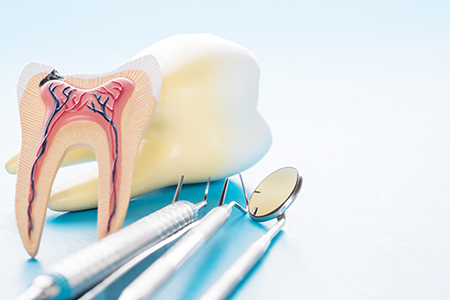North Haven Office

Our Offices
41 Middletown Ave
North Haven, CT 06473
Existing Patients: (203) 234-3900
New Patients: (203) 309-2799
Cromwell Office

If your dentist recommends a root canal, there’s no reason to panic. Modern root canal therapy is a standard, well-established treatment that relieves tooth pain, removes infection, and preserves the tooth rather than removing it. For many people, a timely root canal is the most predictable way to keep a natural tooth functioning comfortably for years.
At the office of Nova Dental, we combine gentle care with up-to-date techniques to deliver precise root canal therapy. Our focus is on patient comfort, clear communication, and outcomes that protect your oral health and your smile.
Root canal therapy is designed to remove damaged or infected tissue from the inside of a tooth and then seal that space to prevent reinfection. By addressing the source of deep decay or injury, the procedure stops pain and gives the tooth a chance to heal — all while keeping the natural structure in place. Avoiding extraction whenever possible helps preserve chewing function and prevents the jawbone changes that can follow tooth loss.
Advances in instrumentation and filling materials mean the treated tooth can often be restored to near-normal strength and function. After the interior of the tooth is cleaned and sealed, most teeth are crowned or otherwise rebuilt to protect them from fracture and to restore full function. With appropriate restoration and routine care, a root canal-treated tooth can last for many years.
Because the procedure targets the infected or inflamed pulp (the nerve and connective tissue inside a tooth), root canal therapy is often the best option for resolving persistent pain and preventing the spread of infection to surrounding teeth or bone. Early intervention usually makes treatment easier and more predictable.

Teeth hide a central chamber filled with nerves, blood vessels, and connective tissue, which together are called the dental pulp. This tissue helps a tooth develop and gives sensory feedback throughout life. When bacteria reach the pulp through deep decay, cracks, or trauma, inflammation and infection can follow — and that’s when a root canal may be necessary.
Not all sensitivity means the pulp is irreversibly damaged, but persistent symptoms such as deep, throbbing pain or pain that wakes you at night are classic red flags. Likewise, sudden, intense sensitivity to hot or cold that lingers, or sharp pain when biting, can indicate that the inner tissues are compromised and should be evaluated promptly.
In some cases, a problem is discovered before symptoms begin — for example, a routine exam and X-rays may reveal changes around a tooth’s root tip that suggest infection. Because these findings can precede serious complications, timely assessment and treatment planning are important to protect adjacent teeth and supporting bone.
Below are common signs that often accompany pulp damage or infection. If you notice any of these, schedule an evaluation so we can determine the best course of care.
A lingering deep ache that grows worse over time — especially pain that interrupts sleep or remains after typical remedies — often points to the need for professional care. This type of pain typically requires diagnosis and treatment rather than home remedies.
Brief sensitivity is common, but intense or prolonged discomfort when consuming hot or cold foods and beverages can signal inflamed or dying pulp tissue that needs attention.
Discomfort that occurs when pressure is applied — whether chewing or tapping the tooth — can indicate internal damage or infection and should be assessed promptly.
Tooth discoloration after an injury or over time may reflect changes inside the tooth. A dark or grayish appearance can be a sign the internal tissues have been affected and warrant an exam.
Structural damage from an accident or bite force can extend into the pulp, allowing bacteria to invade. Even a small crack can lead to internal inflammation that necessitates treatment.
Swollen gums or a pimple-like bump on the gum near a tooth may indicate an abscess — an infection that requires prompt attention to prevent spread.
Infection around the root can weaken the supporting bone and ligaments, leading to mobility. Treating the source often allows healing and restores stability.

Treating a problematic tooth before an infection spreads makes the process less complex and improves the chances of preserving the tooth. Delaying care can allow bacteria to advance into the root system and surrounding bone, increasing the likelihood of swelling, pain, and more intensive treatment.
Regular dental exams and X-rays help us spot trouble early — sometimes before you even notice symptoms. When signs of root-tip changes or internal breakdown show up on radiographs, it’s often the ideal time to intervene to prevent more extensive damage.
Prompt treatment reduces the risk that an infection will compromise adjacent teeth or require surgical approaches. Early communication about symptoms and rapid evaluation are the best pathways to straightforward, successful care.
Root canal treatment has become much more comfortable thanks to improvements in anesthetics, instruments, and techniques. In most cases the tooth is numbed with local anesthesia so you remain comfortable while the internal tissue is removed, the canals are cleaned and shaped, and the space is sealed with a biocompatible material.
Depending on the tooth’s anatomy and the presence of infection, a root canal can often be completed in a single visit, though some cases benefit from a short series of appointments. Our clinicians tailor the plan to the specific tooth, explaining steps and options so you know what to expect.
If dental anxiety is a concern, additional relaxation options are available to help you remain calm and comfortable throughout treatment. After the interior work is complete, the tooth typically receives a protective restoration — often a crown — to restore strength and long-term function.

After treatment you may notice mild soreness as surrounding tissues settle, but this typically eases within a few days. We provide guidance on over-the-counter pain relief and activity adjustments to keep healing comfortable. Maintaining good oral hygiene supports recovery and reduces the chance of future problems.
Because a root canal removes the tooth’s living core, the treated tooth can be more brittle than an untouched tooth. Placing a permanent crown or durable restoration in a timely way restores strength and helps prevent fractures. Until that restoration is placed, avoid hard or sticky foods on the treated side.
If antibiotics are prescribed to address or prevent infection, take the full course as directed. And if you experience rising pain, swelling, or any unexpected changes after treatment, contact the practice so we can evaluate you promptly.
Numbness from local anesthesia can persist for an hour or two. During this time, be cautious to avoid inadvertently biting your cheek, lip, or tongue until full sensation returns.
Some tenderness around the treated tooth is expected as tissues heal. This usually subsides with simple measures and time; follow any home-care instructions we provide for the best recovery.
If antibiotics are part of your treatment plan, complete the entire course to ensure the infection is addressed effectively.
Even after the root canal, the remaining tooth structure can be vulnerable. Avoid chewing hard foods on that side until the final restoration is placed to reduce risk of a fracture.
Brushing and flossing as usual supports healing and the long-term health of the treated tooth and surrounding teeth.
Scheduling the permanent crown or restoration without delay helps secure the success of the procedure and restores full function.
With careful technique, appropriate restoration, and ongoing home care, a tooth that has undergone root canal therapy can remain a reliable part of your smile for many years. At the practice of Nova Dental, we are committed to explaining options clearly and delivering care that prioritizes your comfort and long-term oral health.
For more information about root canal treatment or to discuss your specific situation, please contact us to arrange an evaluation. We’re here to help you make informed choices and keep your smile healthy.
A root canal procedure is the best way to save a tooth that has been damaged by decay or injury and preserve your natural smile. The alternative is an extraction and treatment to replace the tooth. While at times a tooth is non-restorable and an extraction is the only option, when possible, it’s best to try and save your natural tooth. With proper care, a tooth with root canal therapy can serve your smile well for many years to come.
Despite lingering myths from before the age of modern dental anesthesia and technology, having a root canal procedure today is as routine and comfortable as visiting the dentist for a filling. While the procedure is performed under local anesthesia with your tooth completely numbed, we can also discuss options in dental sedation.
Whether the symptoms of a dental infection subside after a course of antibiotics, a draining abscess provides you with some temporary pain relief, or a tooth with radiographic evidence of pathology has not yet developed symptoms, it’s essential, before an infection worsens or occurs, to have a root canal procedure performed. In this way, the tooth can be disinfected, filled, and sealed to protect your health and avoid further problems.
If you have sustained a dental injury, have a toothache, jaw pain, swelling, or are experiencing any other unusual and uncomfortable oral symptoms, contact our office immediately for care. Dental problems that have not been evaluated and treated can significantly worsen, producing more severe damage and consequences for the involved teeth, your oral health, and even your overall wellbeing. Once you get in touch with our office, our friendly and compassionate office team will get you in for care at your earliest convenience.
While some root canal procedures can be completed in one visit, others may involve 2 or 3 appointments. How long it takes depends on various factors, including active infection, the number of canals in the tooth, and the tooth’s location or anatomy.
With a success rate that exceeds 95%, root canal therapy remains the most effective procedure to save a tooth in which the inner vital tissues have been damaged. However, as with all healthcare procedures, there are a small percentage of cases where the teeth become symptomatic a second time. The good news is that many of these teeth can still be saved with root canal retreatment or a minor surgical procedure known as an apicoectomy.
The best ways to maintain a tooth with root canal therapy are to get the proper restoration required to rebuild and protect the tooth, maintain proper oral hygiene, and schedule appointments for routine dental checkups and care.
Saving a tooth with root canal therapy is a wise investment that, in the long run, is typically less costly and invasive than having the tooth extracted and replaced with a fixed bridge or implant. As far as the exact cost of care, it can vary depending on which tooth is being treated. Many dental insurance plans provide coverage for root canal therapy. At the office of Nova Dental, we do our best to optimize your dental benefits and minimize your out-of-pocket expenses. Our staff will answer all your questions about the cost of care and discuss all your payment options.
At the office of Nova Dental, we use the latest technology and most effective methods of care to provide precise and gentle care. Our reputation for excellence is based upon a consistent record of achieving successful treatment outcomes while providing prompt, stress-free, and convenient treatment for every type of dental need.
A root canal is a dental procedure that removes infected or inflamed pulp from inside a tooth and seals the canals to prevent reinfection. The pulp contains nerves and blood vessels that can become compromised by deep decay, cracks, or trauma, leading to persistent pain or spreading infection. Treating the interior of the tooth preserves the natural tooth structure and avoids extraction when possible.
At Nova Dental we combine gentle care and modern techniques to make root canal therapy predictable and comfortable. Early diagnosis and treatment often simplify the procedure and improve long-term outcomes. If a dentist identifies pulp damage or infection, a root canal is frequently the most reliable option to relieve pain and protect surrounding tissues.
Root canal therapy removes the damaged or infected pulp tissue that is the source of pain and potential spread of infection. After cleaning and shaping the canals, the space is filled with a biocompatible material and sealed to block bacteria from re-entering. This internal repair allows the outer tooth structure to remain in place and function for chewing and speaking.
Following the canal treatment, most teeth are restored with a durable restoration such as a crown to protect against fracture and restore full function. Advances in instrumentation and filling materials help treated teeth regain near-normal strength. With proper restoration and routine care, a treated tooth can serve reliably for many years.
Persistent, throbbing tooth pain that worsens over time, especially pain that interrupts sleep, is a common indication of pulp involvement. Intense or prolonged sensitivity to hot or cold, sharp pain when biting, noticeable darkening of a tooth, or swelling near the affected tooth should prompt a dental exam. In some cases, routine X-rays reveal changes at the root tip before symptoms begin, so regular exams are important.
Visible chips, cracks, or a history of trauma can allow bacteria to reach the pulp and lead to infection even without immediate pain. A pimple-like bump on the gum or tooth mobility are additional signs that require prompt attention. Early evaluation increases the chance of simple, successful treatment and helps protect adjacent teeth and bone.
Most modern root canal procedures begin with local anesthesia to ensure the tooth and surrounding tissues are numb and comfortable. The dentist creates a small access opening to remove the diseased pulp, then cleans, shapes, and disinfects the canal system using precision instruments and irrigation solutions. After drying the canals, they are filled with a biocompatible material and sealed to prevent reinfection.
Depending on the tooth and the presence of infection, the treatment may be completed in a single visit or staged over two appointments for optimal results. Once the interior work is finished, the tooth is restored with a filling or crown to reinforce strength and restore appearance. Clinicians will explain each step so patients know what to expect throughout the visit.
Root canal therapy is typically no more uncomfortable than having a filling because local anesthesia effectively numbs the treatment area. Improvements in anesthetic techniques, instruments, and patient-focused protocols have significantly reduced procedure-related pain. Many patients report relief from the severe pain they experienced before treatment once the infected tissue is removed.
Mild soreness or tenderness around the treated tooth is common for a few days as the surrounding tissues heal, and this is usually managed with over-the-counter pain relievers and simple home-care measures. If dental anxiety is a concern, clinicians can discuss additional relaxation options to help you remain calm and comfortable during the procedure. Contact the office if pain increases or does not improve as expected so the team can evaluate your recovery.
Most patients experience mild soreness for a few days after a root canal as inflammation subsides and tissues heal. Stiffness and tenderness when biting are common but typically improve with time and conservative measures such as short-term pain relievers and soft foods. Numbness from local anesthesia will wear off within a few hours, so patients should take care to avoid chewing on the treated side until sensation returns.
A permanent crown or other definitive restoration is usually recommended soon after root canal therapy to protect the tooth from fracture and restore full function. If antibiotics are prescribed, complete the entire course as directed to address any infection. If swelling, increasing pain, or other unexpected symptoms occur after treatment, contact the practice at the North Haven or Cromwell office for prompt evaluation.
A crown is commonly recommended for teeth that have undergone root canal therapy, especially molars and premolars that endure heavy chewing forces. The procedure removes the tooth's living core, which can make the remaining structure more brittle, so reinforcing the tooth with a crown helps prevent fractures and restores long-term function. Anterior teeth with minimal structural loss may sometimes be restored with a strong filling instead of a crown.
Your dentist will evaluate the amount of remaining tooth structure, the tooth's location, and functional demands to recommend the most appropriate final restoration. Timely placement of the restoration is important to protect the root canal treatment and maximize the tooth's longevity. The team will discuss timing and restoration options based on your individual situation.
Although root canal therapy is highly successful, failure can occur if bacteria remain in hidden canal branches, if a restoration leaks, or if new decay exposes the tooth to reinfection. Persistent or recurrent symptoms, new swelling, or radiographic changes at the root tip may indicate that additional care is needed. When a treated tooth does not heal as expected, options include retreatment of the canals, surgical endodontic procedures, or extraction depending on the specific circumstances.
Retreatment can address missed anatomy or persistent infection by revisiting and thoroughly disinfecting the canals before resealing them. In cases where retreatment is unlikely to succeed or the tooth is not restorable, extraction followed by a replacement plan may be discussed. Your clinician will explain the rationale for recommended next steps and help you weigh the benefits and risks of each option.
Good preventive care is the best strategy to lower the risk of needing a root canal. Daily brushing and flossing, routine dental exams, and periodic X-rays help catch decay and fractures early, often before the pulp becomes involved. Wearing a mouthguard during contact sports and addressing bite-related stress can also reduce the chance of traumatic injury or cracks that lead to pulp damage.
Timely treatment of cavities and prompt attention to cracked or sensitive teeth are important to prevent bacterial entry into the pulp chamber. Discussing protective restorations and monitoring high-risk teeth during regular visits helps preserve natural teeth for the long term. The dental team can tailor prevention strategies to your oral health needs and risk factors.
Choosing between extraction and root canal therapy depends on the tooth's restorability, the extent of infection or damage, overall oral health, and the patient's goals. When a tooth can be effectively cleaned, sealed, and restored, a root canal is often preferred because it preserves natural structure and maintains chewing function. Extraction may be recommended when a tooth is fractured below the gumline, extensively decayed beyond restoration, or when systemic factors make retention inadvisable.
The dentist will review clinical findings, radiographs, and restorative options to present a clear treatment plan, including the expected outcomes and steps required to restore the area after extraction if that route is chosen. In both scenarios the priority is to address pain and infection while supporting long-term oral health. Your clinician at Nova Dental will explain the factors that influence the recommendation and help you make an informed decision.
